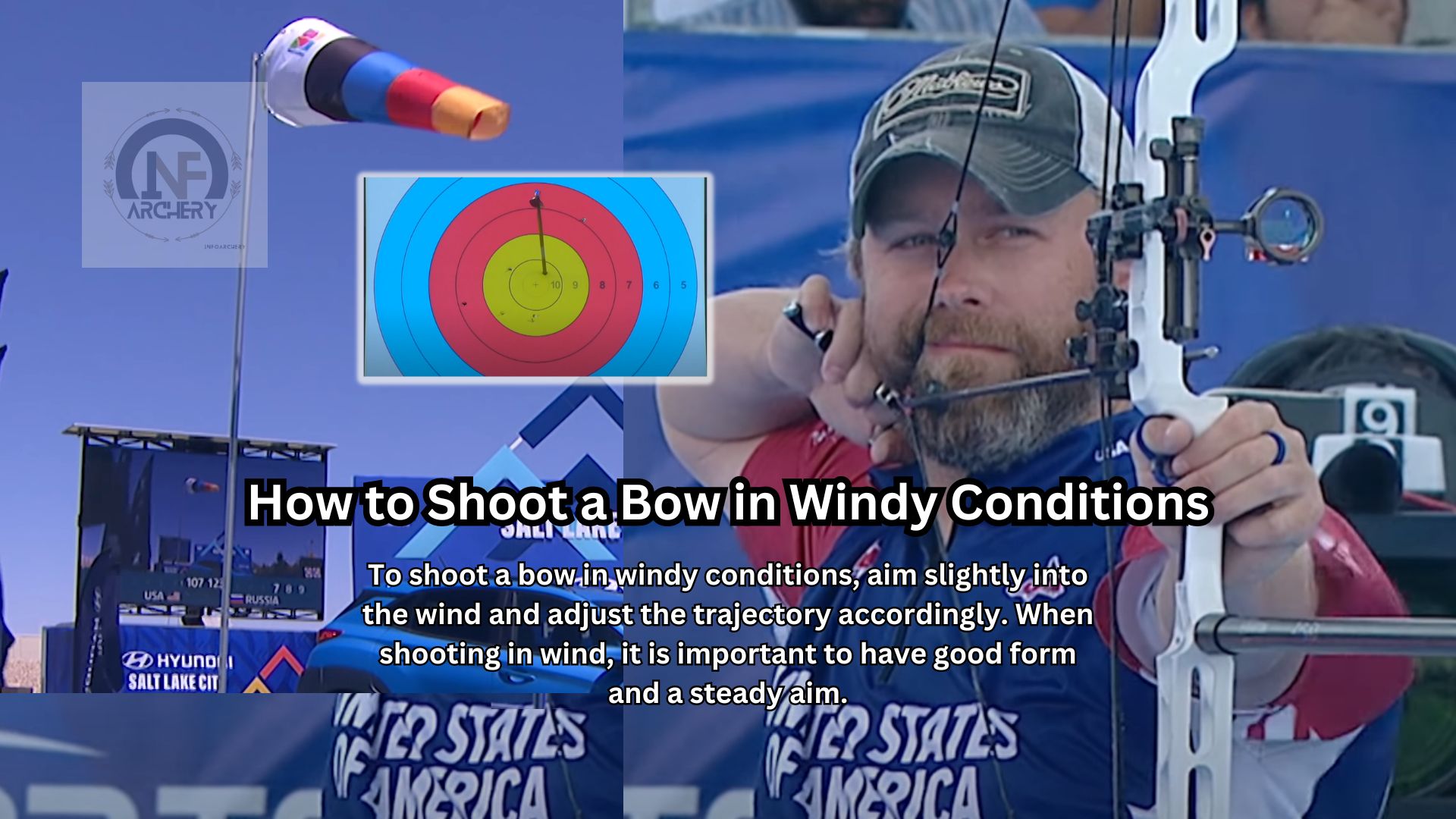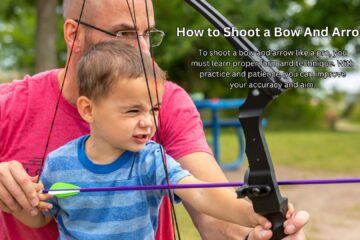To shoot a bow in windy conditions, aim slightly into the wind and adjust the trajectory accordingly. When shooting in wind, it is important to have good form and a steady aim.
Shooting a bow is a skill that takes time and practice to perfect. Shooting in windy conditions adds another layer of difficulty that requires specialized techniques and adjustments to shoot accurately. Whether you are an experienced archer or a novice, understanding how to shoot a bow in windy conditions can greatly improve your accuracy and success.
In this article, we will discuss the proper techniques for shooting a bow in windy conditions, such as selecting the right equipment, adjusting for wind speed and direction, and utilizing good form and aiming practices. With the right approach, you can shoot a bow in even the windiest of conditions with precision and confidence.
Related Post: Different Archery Shooting Techniques: Gap Shooting, String Walking, And More
Understanding Wind Patterns
Shooting a bow in windy conditions can be a challenge for even the most experienced archers. Wind patterns have a significant impact on arrow flight, so it’s essential to understand them before you shoot. Here’s what you need to know:
- Wind is unpredictable and can change direction and speed rapidly
- Wind is affected by temperature, altitude, and terrain
- Wind can either be a headwind, tailwind, crosswind, or gust
Common Wind Patterns And How They Affect Arrow Flight
Different wind patterns affect arrow flight differently. Knowing and understanding these patterns are crucial to improve your chances of hitting the bullseye. Here are the three common wind patterns to look out for when shooting:
- Headwind – this occurs when the wind blows from the opposite direction of your arrow. A headwind can make your arrow slow down, and it can also affect its trajectory, causing it to dip down. You may need to adjust your aim if you encounter a strong headwind.
- Tailwind – this is the opposite of the headwind, and it occurs when the wind is blowing in the same direction as your arrow. Tailwinds can speed up your arrow, making it fly faster and farther. It may cause your arrow to fly higher than usual, so make sure to aim accordingly.
- Crosswind – this occurs when the wind is blowing perpendicular to your arrow’s flight path. Crosswinds can cause your arrow to drift sideways, making it challenging to hit your target. To counteract this, you may need to shoot your arrow slightly off-target, depending on the wind’s strength and direction.
Utilizing Diagrams Or Images To Illustrate Wind Patterns
Diagrams or images can be helpful in illustrating wind patterns and understanding how they affect arrow flight. Below are some examples of diagrams that can help you:
- Wind rose diagrams – these diagrams show the frequency and direction of the wind in a particular area. They can help you predict the wind pattern you may encounter and determine which direction you should aim your arrow.
- Wind sock diagrams – these are simple diagrams that show the direction and relative speed of the wind. They can help you identify the wind’s direction and strength, giving you an idea of what type of wind pattern you may encounter.
Understanding wind patterns is essential to shoot a bow accurately in windy conditions. By knowing the common wind patterns and their effects on arrow flight, you can adjust your aim and increase your chances of hitting the bullseye. Using diagrams or images can help you visualize these patterns and make it easier to shoot accurately.
Keep these tips in mind, and you’ll be able to shoot a bow in windy conditions like a pro.
Related Post: How to Shoot a Bow And Arrow Like a Pro
Mastering The Art: Shooting A Bow In Windy Conditions
Shooting a bow can be a challenging task, especially when the wind is against you. It’s not just about aiming at the target; you must also factor in the direction and velocity of the wind. Mastering the skill of shooting a bow in windy conditions is a vital aspect of becoming an expert archer.
Discuss How Mastering Shooting In The Wind Is Viewed As “An Art”
Shooting in the wind is seen as an art because archers must analyze the wind’s direction and strength to make accurate shots. It takes time, practice, and patience to master the skill of shooting in varying windy conditions. To become an expert archer, you must understand and learn how to adjust to the changing wind conditions.
Explain How Wind Conditions Can Make Or Break A Shot
An archer must be mindful of the impact of wind conditions on their shots. A strong gust of wind can easily make the arrow drift away from the target, leading to inaccurate shots. Here are some factors to consider when shooting in windy conditions:
- Wind direction: Archers must understand the wind’s direction and position themselves accordingly to make accurate shots.
- Wind strength: The stronger the wind, the more significant its impact on the arrow. Archers must learn how to adjust their aim to compensate for the wind’s strength.
- Distance: The distance between the bow and the target also affects the impact of wind on the arrow. The farther the target is, the harder it is to make an accurate shot.
Learning to shoot a bow in windy conditions is essential for every archer who wants to enhance their skills. Practice regularly, analyze the wind’s direction and strength, and adjust your aim accordingly. With enough practice and patience, you can become an expert archer, capable of shooting accurately even in high winds.
Tips For Shooting In The Wind
Shooting a bow in windy conditions can be a tricky proposition, even for experienced archers. However, with the right combination of adjustments to your technique and equipment, you can still shoot with accuracy and confidence. Here are some tips for shooting in the wind:
Adjust Your Shooting Technique
- Stand perpendicular to the wind to avoid being blown off balance
- Widen your stance for extra stability, placing more weight on your front foot
- Use a lower draw weight to make it easier to hold your aim
- Use a shorter draw length to avoid overexertion
- Release your shot as soon as your sight pin aligns with your target
- Be patient and persistent, and eventually, you’ll develop a sense of how much the wind will influence your shot.
Equipment Adjustments
- Using heavier arrows to make them more resistant to wind
- Use larger fletchings to increase arrow stability
- Try using a bow stabilizer to help offset any movement caused by wind.
Reading Wind Conditions
- Look for indicators that can tell you how wind is blowing. For instance, lightweight items like feathers or leaves on the ground for wind direction. Or, you may notice the effects of wind on trees, or other windbreaks.
- Try to shoot when the wind is less intense, such as in the morning or evening when the wind tends to die down a bit.
- If the wind is gusting unpredictably, focus on timing your shots to coincide with periods of calm.
With these tips, you’ll be better equipped to hit your targets and deal with windy conditions more effectively. Remember, consistency is key, and practice makes perfect. Aim high and shoot straight!
Adjusting Your Shot In Windy Conditions
When shooting a bow, there are a few factors that can massively alter the trajectory of an arrow in windy conditions. For this reason, it’s crucial to adjust your shot according to both the wind’s direction and velocity. Here are a few tips to help you shoot accurately in the wind:
Adjust your precise aim according to the wind’s Direction And Velocity
Determining the direction and velocity of the wind is vital in adjusting your aim correctly. Here’s how you can adjust your aim according to the wind’s direction and velocity:
- Observe the direction of the wind: Look for trees, flags, or anything else that will help you determine the direction of the wind. The angle of these objects will give you a rough idea of the wind’s direction.
- Determine the wind’s velocity: Pay attention to the movement of the objects around you. This will give you an idea of how fast the wind is blowing.
- Compensate for the wind’s effect on the arrow: Aim slightly left or right according to the wind’s direction. For example, if the wind is blowing left, aim slightly to the right. If the wind is blowing right, aim slightly to the left. The amount you adjust your aim will depend on the intensity of the wind.
Adjust Your Shot’s Force To Account For Tail Or Head Winds
Tail or head winds can drastically alter the trajectory of an arrow. Here’s how you can adjust the force of your shot to account for tail or head winds:
- If the wind is blowing from behind: A tailwind can cause your arrow to hit high. Aim slightly lower than you would normally.
- If the wind is blowing from the front: A headwind can cause your arrow to drop faster than usual. Aim slightly higher than you would normally.
- If the wind is blowing from the side: A crosswind can cause your arrow to travel sideways. Aim slightly in the opposite direction from the wind’s force.
By adjusting your aim and shot’s force, you can improve your accuracy in windy conditions. Remember to observe the wind’s direction and velocity and practice regularly to improve your skills.
Frequently Asked Questions For How To Shoot A Bow In Windy Conditions
How Can I Ensure Consistent Shots In Windy Conditions?
To ensure consistent shots in windy conditions, you need to focus on form, have a good stance, and have confidence in your ability. Anticipate the wind direction and adjust your aim accordingly by aiming slightly to the side of the target.
Should I Adjust My Bow For Windy Conditions?
Yes, adjusting your bow for windy conditions is crucial. You can lower your draw weight, and use heavier arrows with larger fletching to help stabilize your shot. Ensure that your bow’s grip is perpendicular to the ground to avoid any torque that may be caused by the wind.
How Does Wind Affect The Trajectory Of The Arrow?
Wind can significantly affect the trajectory of the arrow, causing it to drift off course. Crosswinds will cause the arrow to drift left or right depending on the wind’s direction. Head or tailwinds will cause the arrow to drop faster or slower than usual.
It’s important to anticipate these changes and adjust your aim accordingly.
Can I Still Shoot In Strong Winds?
You can still shoot in strong winds, but it will require extra effort and skill. Start by observing the wind patterns before taking your shot. Begin with short distances and gradually move back further while still maintaining a consistent technique.
Remember, safety is crucial; don’t attempt to shoot if the wind is too strong.
What Gear Can I Use To Shoot a Bow in Windy Conditions?
When shooting in windy conditions, it is essential to use stable gear that can withstand the wind. Use a heavier bow stabilizer and heavy arrows with large fletching to ensure stability. You can also invest in a wind checker powder or a wind gauge to keep track of wind speed and direction while shooting.
Conclusion
As a bowhunter, learning to shoot in windy conditions is an essential skill to master. Windy conditions can create havoc on your shots, but with the right technique and strategy, you can overcome this challenge. By starting with proper footing and stance, understanding the direction and intensity of the wind, selecting the appropriate arrow, and adjusting your aim accordingly, you can significantly improve your accuracy and precision while bowhunting in windy conditions.
Remember, practice makes perfect, so it’s important to train regularly in different weather conditions. By implementing these tips and tricks, you’ll be well on your way to becoming a successful and skilled bowhunter. So next time you’re faced with windy conditions, don’t shy away from the challenge, embrace it with confidence and take your shot with precision.
Happy hunting!







